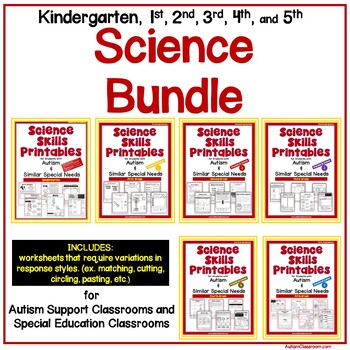BUNDLE- Science Printables for Students with Autism (K-5)
- Zip
What educators are saying
Products in this Bundle (6)
showing 1-5 of 6 products
Description
Science Worksheets for Autism Support Classrooms / Adapted Science / Special Education Science
This is a bundle of the printables for science for students with developmental delays who are learning about science. The Science Skills Printables will work well for any students whose special needs include developmental delays and it also may work for younger students in primary grades learning to develop science skills.
The Printables can supplement a science curriculum or they can be used daily as a discussion starter for developing science skills. This packet includes science related worksheets that require variations in response styles for many answers. (Ex. matching, cutting, circling, pasting, etc.)
K-5 worksheets are available in this bundle. They are standards aligned.


